Self-Portrait With Thorn Necklace and Hummingbird – Frida Kahlo
Self-Portrait with Thorn Necklace and Hummingbird by Frida Kahlo is one of her most iconic and powerful works. In this article, we will take a closer look at this Frida Kahlo self-portrait by placing it in the context of the artist’s life and career. We will then complete a visual analysis of the thorn necklace painting, and discuss the impact that Frida Kahlo’s self-portraits had on art history.
Contents
- 1 Artist Abstract: Who Was Frida Kahlo?
- 2 Self-portrait with Thorn Necklace and Hummingbird by Frida Kahlo in Context
- 3 A Brief Overview of Frida Kahlo Self Portraits
- 4 Self-portrait with Thorn Necklace and Hummingbird Analysis
- 5 The Development of Frida Kahlo Self Portraits: A Brief Comparative Analysis
- 6 Why Is Self-Portrait with Thorn Necklace and Hummingbird by Frida Kahlo So Influential?
- 7 Frequently Asked Questions
Artist Abstract: Who Was Frida Kahlo?
Frida Kahlo (1907 – 1954) was a Mexican artist known for her self-portraits and her portrayal of female understanding. She was born in 1907 in Mexico City and was the third of four children. From a young age, she was interested in art and began drawing and painting at a young age. She attended the National Preparatory School in Mexico City, where she studied art and was influenced by the Mexican muralists, who were creating large-scale public artworks that depicted Mexican history and culture.
In 1925, Kahlo was involved in a severe bus crash that left her with multiple injuries and in pain for the rest of her life.
Her accident, her recovery, and her marriage to Mexican muralist Diego Rivera (1886-1957) were significant influences on her art. Many of her paintings depict her physical and emotional suffering. Her early artworks were mostly self-portraits, which she used as a way to explore her emotions and inner turmoil.
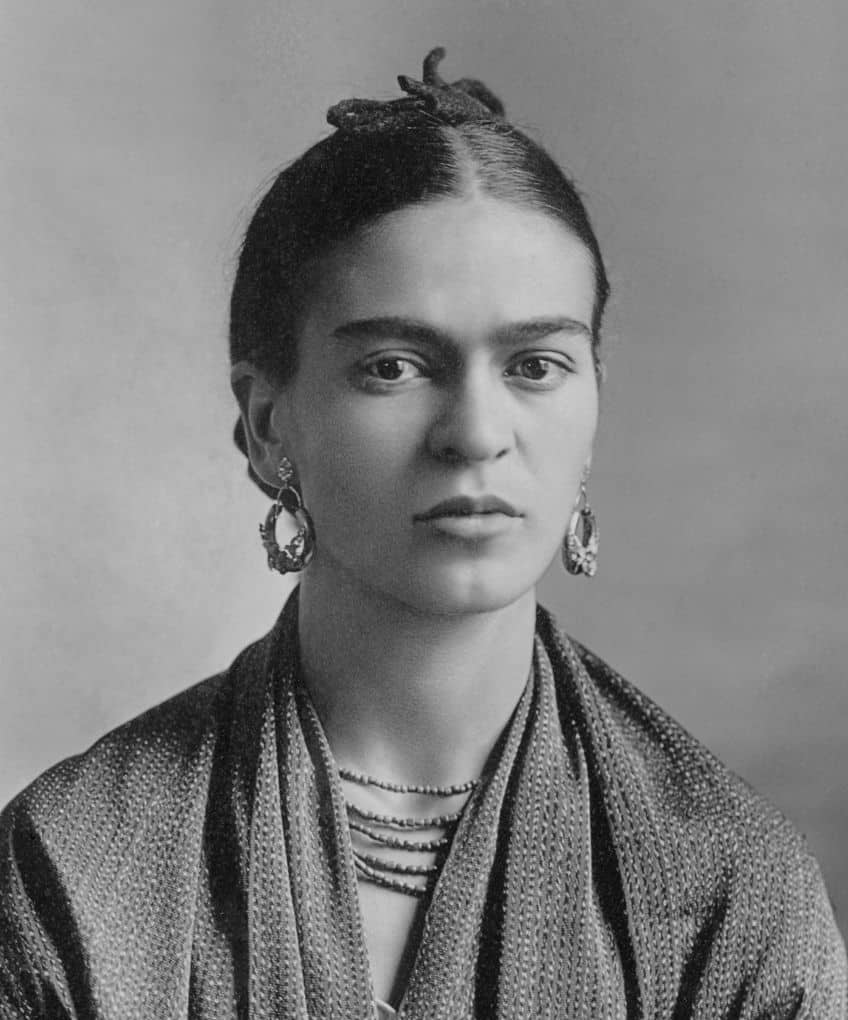
Kahlo’s most famous paintings include Self-Portrait with Thorn Necklace and Hummingbird (1940), The Two Fridas (1939), and The Broken Column (1944). These paintings are considered some of the most powerful and emotional self-portraits ever created, and they explore themes of identity, gender, and pain. Kahlo’s work resonated with the Surrealism movement that was developing parallel to her career in Europe and America. This art movement sought to explore the subconscious mind through art.
She also drew inspiration from Mexican Symbolism and traditional arts and crafts, which uses symbols and imagery to express deeper meanings. Kahlo’s art is considered a bridge between these various movements.
Self-portrait with Thorn Necklace and Hummingbird by Frida Kahlo in Context
Frida Kahlo’s Self-Portrait with Thorn Necklace and Hummingbird was painted in 1940, at a time when Kahlo was going through a significant period of turmoil and change in her personal and professional life. These shifts, along with the global socio-political situation, influenced her art and led to her becoming one of the most recognizable artists in the world after her death.
| Date | 1940 |
| Medium | Oil on masonite |
| Type of Painting | Self-portrait |
| Movement | Surrealism and Symbolism |
| Dimensions (cm) | 47 x 61 |
| Location | The University of Texas, Austin, United States |
Self-portrait with Thorn Necklace and Hummingbird by Frida Kahlo in Context of Kahlo’s Life
At the time of painting Self-Portrait with Thorn Necklace and Hummingbird, Kahlo was in the midst of a tumultuous relationship with her husband, the famous Mexican muralist Diego Rivera. The couple had an explosive relationship marked by infidelity and periods of separation. In 1939, Kahlo and Rivera separated, and Kahlo moved out of their shared home. She was living alone in the Blue House, the house where she was born and where she would live for the rest of her life.
The painting is seen as a reflection of her emotional state during this period of isolation and pain.
Kahlo’s health was also a significant concern during this time. She had been in a serious bus accident in 1925, which left her with multiple injuries and in chronic pain for the rest of her life. She had undergone several surgeries and spent most of her life in hospital treatment. Her physical pain was a constant presence in her life and is often reflected in her art.
Self-portrait with Thorn Necklace and Hummingbird by Frida Kahlo in Context of Kahlo’s Career
In 1940, Kahlo was also focusing on her professional career. She had been exhibiting her work since the late 1920s, but it wasn’t until the 1940s that people started recognizing her talent. She held her first solo show in Mexico City in 1940, which was a huge success. She also had her first solo show in the United States that year, at the Julian Levy Gallery in New York City. The exhibition was well-received and brought Kahlo international attention.
This was a significant moment in her career, as it marked the beginning of her recognition as a major artist.

In 1940, Kahlo was also working on several other paintings, which were also heavily influenced by her personal experiences. Some of the paintings she was working on during this time include “Self-Portrait with Cropped Hair”, “The Two Fridas” and “The Wounded Table”. These paintings also explore themes of identity, gender, and pain, and were heavily influenced by Surrealism and Symbolism.
Self-Portrait with Thorn Necklace and Hummingbird is a powerful and emotional painting that reflects Kahlo’s state of mind during this tumultuous period in her life. The painting is a self-portrait of Kahlo wearing a crown of thorns and a necklace of thorns. The hummingbird, which is perched on the necklace, is a symbol of the pain and suffering that she was experiencing.
The painting is a powerful expression of Kahlo’s emotional state and is a reflection of her desire to understand and confront her pain.
A Brief Overview of Frida Kahlo Self Portraits
Frida Kahlo’s self-portraits are known for their intense emotional and psychological content. They often depict the artist’s physical and emotional pain, as well as her thoughts and feelings. She used a vibrant, intense color palette and bold brushstrokes to create a sense of raw emotion in her work. Kahlo often included symbolic elements in her self-portraits, such as the monkey, which represented herself, and the parrot, which represented her husband, Diego Rivera. She also incorporated traditional Mexican motifs and elements of nature, such as flowers and vines, into her paintings.
Many of Kahlo’s self-portraits also include elements of surrealism, such as distorted proportions and unexpected combinations of objects. This was in line with her interest in the subconscious and the bridge between the body and the mind. The self-portraits were also a way for Kahlo to explore her identity and her relationship to her culture, body, and gender.
Her work is a powerful representation of the strong and unapologetic woman she was and continues to be an inspiration for feminist and marginalized artists today.
Self-portrait with Thorn Necklace and Hummingbird Analysis
In Self-Portrait with Thorn Necklace and Hummingbird by Frida Kahlo, the artist presents a powerful and intimate self-portrait. Let us look at the compositional overview, subject matter, light and color use, perspective, and symbolism Frida Kahlo applied in creating this artwork.

Compositional Overview
The composition of the painting is quite complex, with the artist’s face taking up the majority of the canvas. She is shown in a three-quarter view, with her head tilted a little to the left. Her eyes look directly at the viewer, creating a sense of direct engagement. Kahlo’s face is the focal point of the painting, and the rest of the composition supports and enhances her gaze’s emotional impact. Her hair is tucked back, exposing her face and the thorn necklace she is wearing. The hummingbird perched on the necklace adds a sense of movement and liveliness to the painting.
On her left shoulder, a monkey is fiddling with her necklace. On her right shoulder, a black cat is also staring straight at the viewer. Behind her, there are lush plants, complemented and framed by strange abstracted flower insects.
Subject Matter
The subject matter of the thorn necklace painting is Kahlo’s emotional pain caused by her separation from Rivera and the isolation she experienced moving away from their shared house. Her direct gaze and stunning surroundings express how she finds comfort in making her own home and being by herself. This Frida Kahlo self-portrait also represents the continuous self-exploration Kahlo did through her art.
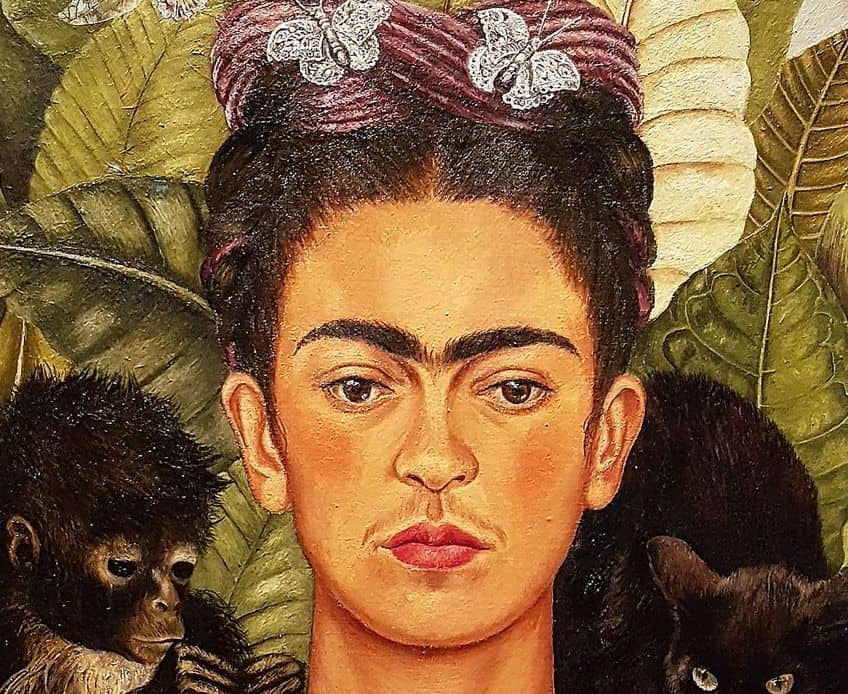
Color and Light
The color palette of the painting is vibrant and intense, with a strong contrast between the warm tones of Kahlo’s skin and the cool tones of the background. The blue background is filled with intricate patterns and symbols, including a monkey and bright winged flowers, which are recurring symbols in Kahlo’s work.
The use of color creates a sense of depth and movement, drawing the viewer’s eye deeper into the painting.
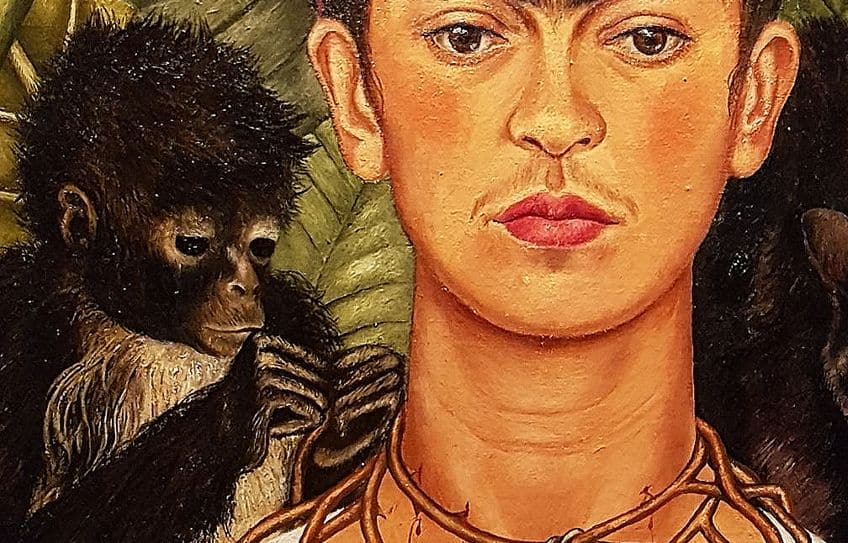
Texture
The texture of the painting is quite varied, with thick, impasto brushstrokes used to create a sense of depth and dimension in the skin and hair, while the background is painted with a smoother, more fluid technique. This creates a sense of contrast between the artist’s face and the background, as well as a sense of movement and liveliness.

Perspective
The perspective of the painting is relatively close-up and intimate, with the artist’s face taking up the majority of the canvas. This close-up view allows the viewer to see the details of Kahlo’s face and the symbols in the background.
The form of the painting is quite realistic, but with a hint of surrealism, as the elements of the background are not in proportion.

Symbolism: Self-Portrait with Thorn Necklace and Hummingbird Meaning
Finally, the symbolism of the painting is quite rich, with the thorn necklace representing pain and struggle and the hummingbird symbolizing love. The monkey and black cat are recurring symbols in Kahlo’s work and may represent different aspects of her life and personality. Overall, the painting is a powerful and intimate self-portrait that conveys the emotional and psychological complexity of the artist.
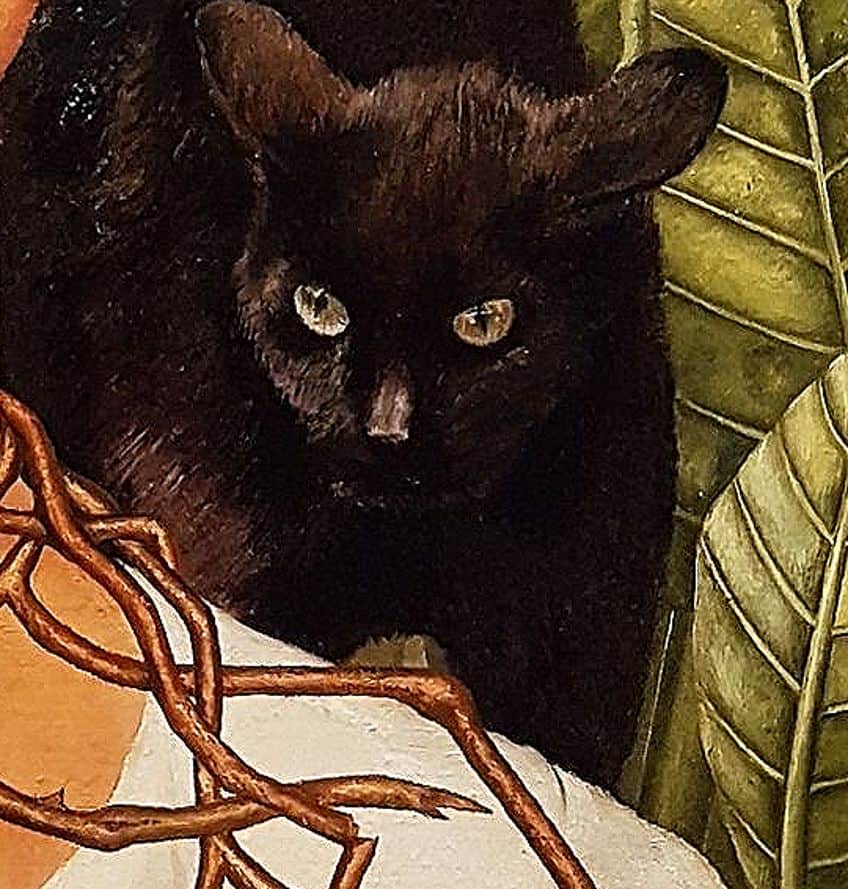
The Development of Frida Kahlo Self Portraits: A Brief Comparative Analysis
Let us do a comparative analysis of Self-Portrait – Time Flies (1929) and Self-Portrait with Thorn Necklace and Hummingbird (1940) painted by Frida Kahlo. These Frida Kahlo self-portraits are quite different in terms of style and symbolism.
Self-Portrait – Time Flies is an early work by Kahlo, painted when she was only 22 years old.
It is a relatively small painting, measuring only 25.5 x 30.5 cm. The painting is quite simple in composition, with a close-up of Kahlo’s face taking up the majority of the canvas. She is shown with a serious expression, with her hair pulled back and her eyes looking directly at the viewer. The background is a neutral color, with very few additional elements or symbols.
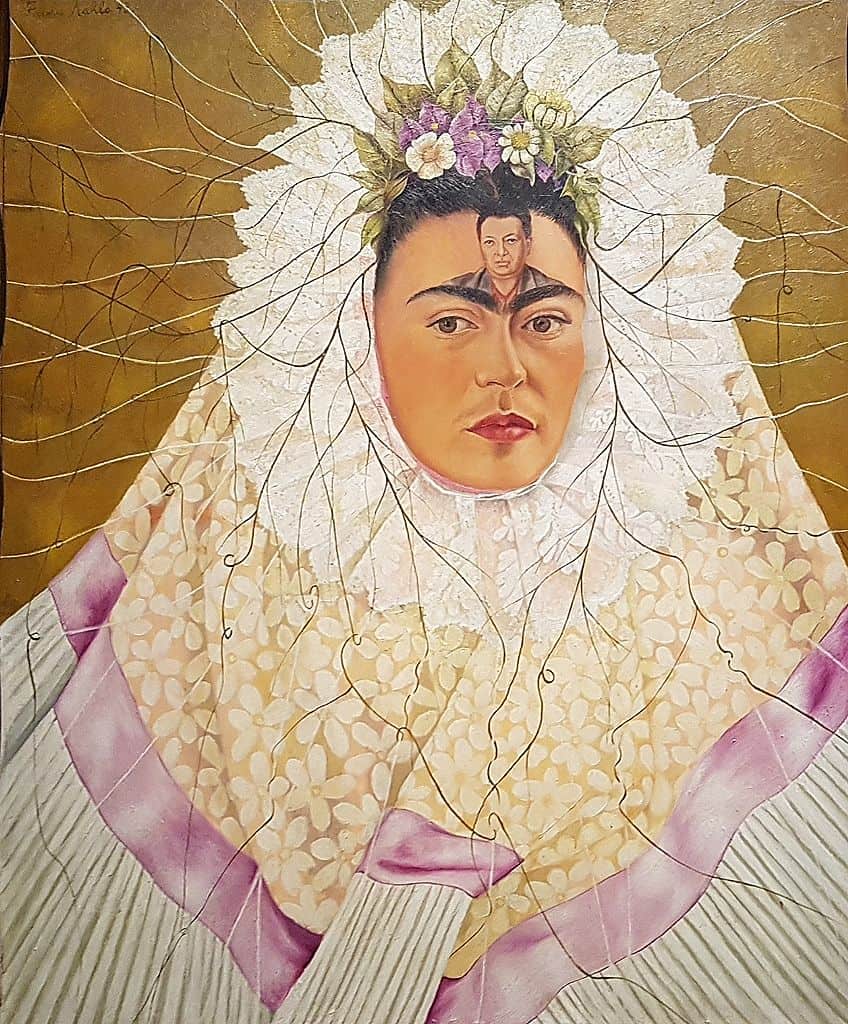
On the other hand, Self-Portrait with Thorn Necklace and Hummingbird is a much more complex and detailed painting. In this self-portrait, Kahlo is shown wearing a necklace made of thorns, with a hummingbird perched on it. The painting measures 55 x 46 cm. The background is a bright, vibrant blue, with intricate patterns and symbols, including a monkey and a parrot, which are recurring symbols in Kahlo’s work.
The hummingbird is a representation of intimacy and love, and the thorns represent pain and struggle.
Overall, the two self-portraits are quite different in terms of composition and symbolism, but both are powerful examples of Frida Kahlo’s self-expression and ability to convey emotion through her art. The first one is a more simple and naive self-portrait, while the second one is a more mature and detailed composition, with a strong symbolic language.
Why Is Self-Portrait with Thorn Necklace and Hummingbird by Frida Kahlo So Influential?
Self-Portrait with Thorn Necklace and Hummingbird by Frida Kahlo is considered a powerful and revolutionary work for several reasons. The painting is deeply personal and reflects the artist’s own physical and emotional pain. At the time it was created, the painting was considered revolutionary in the way it depicted a woman’s experience of pain and suffering. Frida Kahlo’s work was not typical of the art of her time, which often focused on the male viewer and subjectification of women in artistic representations.
Additionally, the painting is a self-portrait, which is also considered a revolutionary act for a woman in the 1940s. Frida’s self-representation in this painting and others was not only a way of claiming agency over her own image but also a way to express her own identity and her own perspective.
Moreover, the painting had a considerable influence on the evolution of Mexican art. Her use of traditional Mexican motifs and elements of nature in her paintings was a powerful statement about the importance of cultural heritage in art. Her style of vibrant, intense color palette and bold brushstrokes was a major influence on contemporary artists, particularly those who work in the fields of Expressionism and Surrealism.
The Critics’ Opinion and the Reception at the First Exhibition
Self-Portrait with Thorn Necklace and Hummingbird by Frida Kahlo was first exhibited in 1940, at the Galería de Arte Mexicano in Mexico City. The painting was one of several self-portraits that Kahlo had created at the time and was received with great interest by the public. The painting was first shown to the public in an exhibition curated by the artist herself, which had more than fifty of her works.
This exhibition was an important milestone in Kahlo’s career, as it was her first solo exhibition in Mexico City and it was widely attended by critics, art lovers, and the general public. Art critics of the time had mixed opinions about the painting. Some praised its emotional intensity and the powerful symbolism of the thorn necklace and hummingbird. Others found the painting to be too self-indulgent and overly personal.
The Mexican art critic, Juan Soriano (1904 – 2006) praised the painting for its powerful emotional expression and striking use of color and symbolism, calling it “a true masterpiece of Mexican art.”
However, the American art critic, Clement Greenberg (1909 – 1994) had a different opinion. He criticized the painting for being too personal and lacking in formal qualities. He argued that the painting was too focused on the artist’s emotional state and did not have a strong enough formal structure. He wrote that “Frida Kahlo’s self-portraits are intense and emotional, but they lack the formal qualities that would make them truly great works of art.”
Despite the mixed reviews, the exhibition was a success, and the painting quickly became one of Kahlo’s most recognized and celebrated works. It is considered one of her most powerful self-portraits and continues to be widely admired and studied by art critics, historians, and the general public.
Today, the painting is considered a masterpiece of Mexican art and it is on permanent display at the Museum of Modern Art in Mexico City.
The Influence of Frida Kahlo’s Self-Portraits on Art History
Kahlo’s self-portraits were not only a reflection of her own identity and experiences, but also an exploration of the human condition and the connection between the mind and the body. Through her art, she explored themes such as gender, identity, and cultural heritage, making her work a powerful representation of the strong and unapologetic woman she was.
One of the most significant ways that Kahlo’s self-portraits have influenced art history is through their impact on feminist art.
Her work served as an inspiration for many feminist artists, who were drawn to her ability to express a sense of self and assert her own identity through her art. One of the most notable feminist artists who was inspired by Kahlo is Judy Chicago (born 1939), whose work often deals with themes of gender, power, and identity. Her installation The Dinner Party (1974-1979) is considered a landmark of feminist art and is inspired by the work of Frida Kahlo.
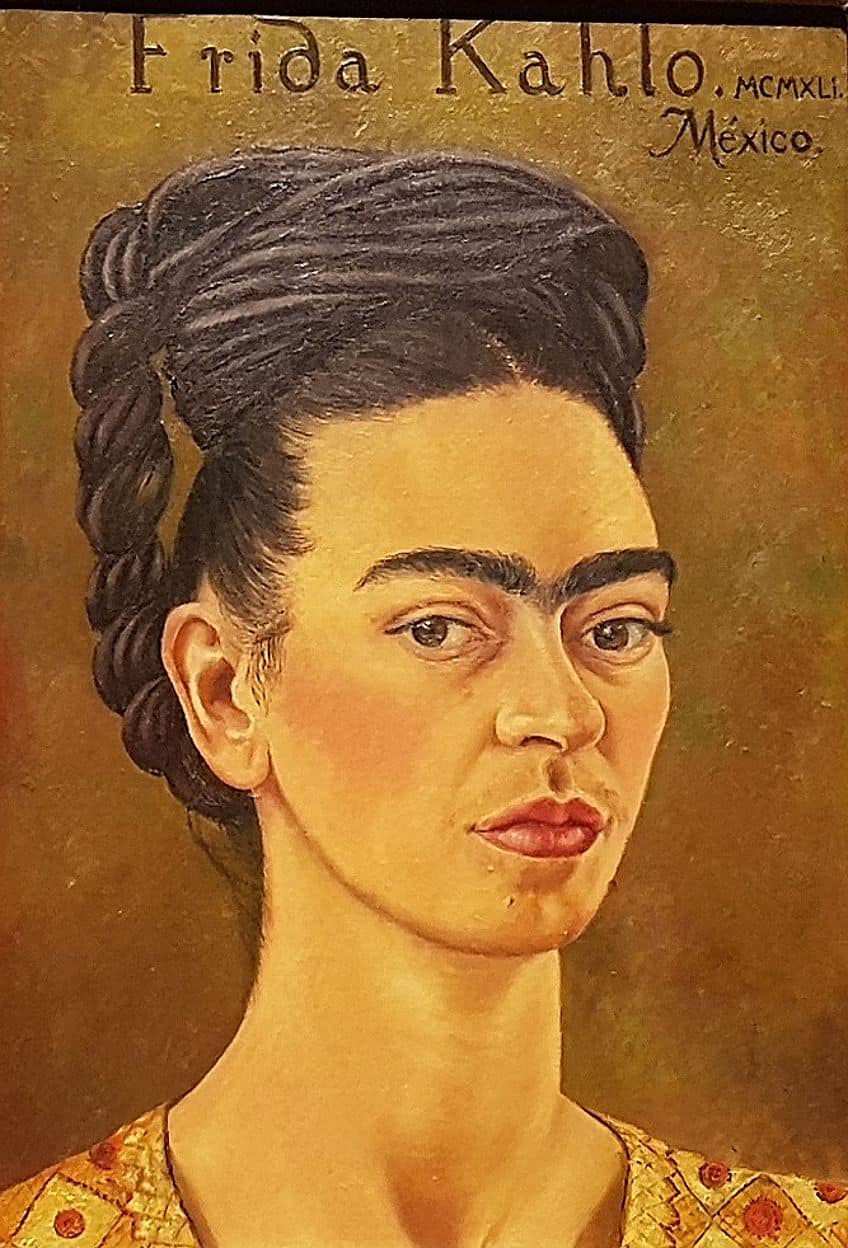
Another artist that was inspired by Frida Kahlo is the Mexican artist Remedios Varo (1908-1963), who was a close friend of Kahlo’s and shared her interest in the subconscious and the connection between the mind and the body. Varo’s work often depicted fantastical and surreal scenes, inspired by her interest in the occult and the paranormal. Her work, like Kahlo’s, is a powerful representation of the strong and unapologetic woman.
Kahlo’s self-portraits also had a notable effect on the growth of Mexican art. Her work, along with that of her husband Diego Rivera, helped to establish a new national identity in Mexican art, one that was based on the country’s indigenous and pre-Columbian culture.
Her use of traditional Mexican motifs and elements of nature in her paintings was a powerful statement about the importance of cultural heritage in art. One of the contemporary artists that were influenced by Frida Kahlo is the Mexican painter and muralist, Francisco Zuniga (1912 – 1998). Zuniga’s work often depicted powerful and emotional self-portraits, which were inspired by the work of Frida Kahlo. His use of vibrant color and strong brushstrokes was similar to Kahlo’s, and his paintings often depicted the human figure in a surreal and fantastical way.
In conclusion, Frida Kahlo’s Self-Portrait with Thorn Necklace and Hummingbird is a powerful and emotional painting that reflects the turmoil and change in her personal and professional life during 1940. Her tumultuous relationship with Diego Rivera, her physical pain, and her focus on her professional career all influenced this painting. It is an expression of her emotional condition and her desire to understand and confront her pain. Her paintings were heavily influenced by Surrealism and Symbolism, and were a bridge between the two movements. The painting continues to be an inspiration for generations to come.
Frequently Asked Questions
Did Frida Kahlo Influence Art History?
Frida Kahlo’s (1907 – 1954) influence on Mexican art history is undeniable. She was one of the first female Mexican artists to gain international recognition and her work has been a major influence on generations of Mexican artists. Her work has been celebrated in Mexico and around the world, and her paintings are considered to be some of the most important works of art of the 20th century. Today, Frida Kahlo is still seen as a feminist icon and her art persists to motivate people and artists around the world.
When Was Frida Kahlo’s Thorn Necklace Painting First Exhibited?
The first exhibition of Self-Portrait with Thorn Necklace and Hummingbird by Frida Kahlo (1907 – 1954) in 1940 was an important event in the artist’s career. The painting was viewed with great curiosity by the public, but critics had mixed opinions about it. While some praised its emotional intensity and powerful symbolism, others found it self-indulgent and lacking in formal qualities. Nevertheless, the painting quickly became one of Kahlo’s most recognized and celebrated works, and it continues to be admired to this day.
What Makes Frida Kahlo’s Portraits So Influential?
Frida Kahlo’s self-portraits are considered to be some of the most powerful and influential works of art of the 20th century. Her ability to convey intense emotions and psychological states through her art has had a significant impact on the art world, and continues to inspire artists to this day.
Nicolene Burger, a South African multimedia artist and creative consultant, specializes in oil painting and performance art. She earned her BA in Visual Arts from Stellenbosch University in 2017. Nicolene’s artistic journey includes exhibitions in South Korea, participation in the 2019 ICA Live Art Workshop, and solo exhibitions. She is currently pursuing a practice-based master’s degree in theater and performance. Nicolene focuses on fostering sustainable creative practices and offers coaching sessions for fellow artists, emphasizing the profound communicative power of art for healing and connection. Nicolene writes blog posts on art history for artfilemagazine with a focus on famous artists and contemporary art.
Learn more about Nicolene Burger and about us.
Cite this Article
Nicolene, Burger, “Self-Portrait With Thorn Necklace and Hummingbird – Frida Kahlo.” artfilemagazine – Your Online Art Source. February 20, 2023. URL: https://artfilemagazine.com/self-portrait-with-thorn-necklace-and-hummingbird-frida-kahlo/
Burger, N. (2023, 20 February). Self-Portrait With Thorn Necklace and Hummingbird – Frida Kahlo. artfilemagazine – Your Online Art Source. https://artfilemagazine.com/self-portrait-with-thorn-necklace-and-hummingbird-frida-kahlo/
Burger, Nicolene. “Self-Portrait With Thorn Necklace and Hummingbird – Frida Kahlo.” artfilemagazine – Your Online Art Source, February 20, 2023. https://artfilemagazine.com/self-portrait-with-thorn-necklace-and-hummingbird-frida-kahlo/.



